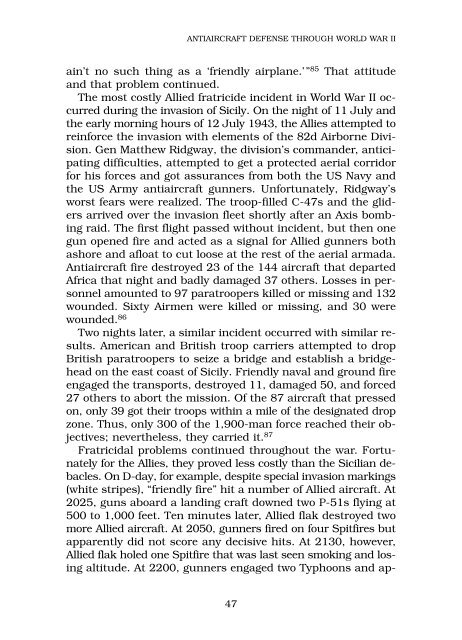Archie to SAM: A Short Operational History of Ground-Based Air ...
Archie to SAM: A Short Operational History of Ground-Based Air ...
Archie to SAM: A Short Operational History of Ground-Based Air ...
Create successful ePaper yourself
Turn your PDF publications into a flip-book with our unique Google optimized e-Paper software.
ANTIAIRCRAFT DEFENSE THROUGH WORLD WAR II<br />
ain’t no such thing as a ‘friendly airplane.’” 85 That attitude<br />
and that problem continued.<br />
The most costly Allied fratricide incident in World War II occurred<br />
during the invasion <strong>of</strong> Sicily. On the night <strong>of</strong> 11 July and<br />
the early morning hours <strong>of</strong> 12 July 1943, the Allies attempted <strong>to</strong><br />
reinforce the invasion with elements <strong>of</strong> the 82d <strong>Air</strong>borne Division.<br />
Gen Matthew Ridgway, the division’s commander, anticipating<br />
difficulties, attempted <strong>to</strong> get a protected aerial corridor<br />
for his forces and got assurances from both the US Navy and<br />
the US Army antiaircraft gunners. Unfortunately, Ridgway’s<br />
worst fears were realized. The troop-filled C-47s and the gliders<br />
arrived over the invasion fleet shortly after an Axis bombing<br />
raid. The first flight passed without incident, but then one<br />
gun opened fire and acted as a signal for Allied gunners both<br />
ashore and afloat <strong>to</strong> cut loose at the rest <strong>of</strong> the aerial armada.<br />
Antiaircraft fire destroyed 23 <strong>of</strong> the 144 aircraft that departed<br />
Africa that night and badly damaged 37 others. Losses in personnel<br />
amounted <strong>to</strong> 97 paratroopers killed or missing and 132<br />
wounded. Sixty <strong>Air</strong>men were killed or missing, and 30 were<br />
wounded. 86<br />
Two nights later, a similar incident occurred with similar results.<br />
American and British troop carriers attempted <strong>to</strong> drop<br />
British paratroopers <strong>to</strong> seize a bridge and establish a bridgehead<br />
on the east coast <strong>of</strong> Sicily. Friendly naval and ground fire<br />
engaged the transports, destroyed 11, damaged 50, and forced<br />
27 others <strong>to</strong> abort the mission. Of the 87 aircraft that pressed<br />
on, only 39 got their troops within a mile <strong>of</strong> the designated drop<br />
zone. Thus, only 300 <strong>of</strong> the 1,900-man force reached their objectives;<br />
nevertheless, they carried it. 87<br />
Fratricidal problems continued throughout the war. Fortunately<br />
for the Allies, they proved less costly than the Sicilian debacles.<br />
On D-day, for example, despite special invasion markings<br />
(white stripes), “friendly fire” hit a number <strong>of</strong> Allied aircraft. At<br />
2025, guns aboard a landing craft downed two P-51s flying at<br />
500 <strong>to</strong> 1,000 feet. Ten minutes later, Allied flak destroyed two<br />
more Allied aircraft. At 2050, gunners fired on four Spitfires but<br />
apparently did not score any decisive hits. At 2130, however,<br />
Allied flak holed one Spitfire that was last seen smoking and losing<br />
altitude. At 2200, gunners engaged two Typhoons and ap-<br />
47
















